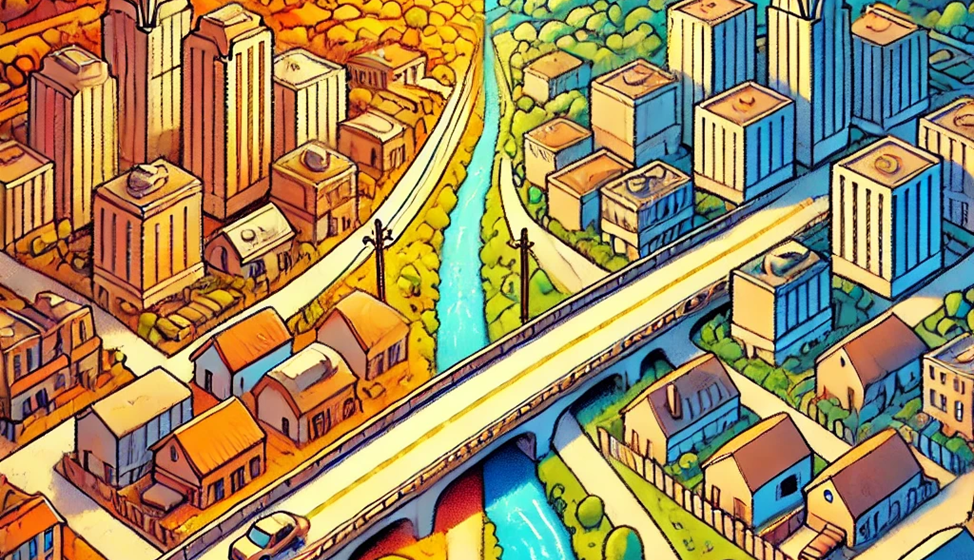Call us at
(786) 536 - 6964
M-F 8am to 5pm
Visit us at
1747 W Flagler St
Miami FL 33135
Call us at
(786) 536 - 6964
M-F 8am to 5pm
Visit us at
1747 W Flagler St
Miami FL 33135

Written by: Javier A. Luque, August 27th 2024
Miami is one of the fastest growing cities in the United States. This growth brings with it long-term challenges that must be carefully addressed. Through urban design, opportunities exist to be made or squandered. Intelligently executed, urban design can have long-lasting revitalizing effects that help neighborhoods grow and flourish. Conversely, the effects could be equally devastating. A new infrastructure project in the heart of Miami currently dubbed ‘The Project’, will seek to undo previous urban planning mistakes and execute a new vision for district connectivity, featuring a monumental arch. How will this be accomplished? To fully understand, it’s important to see the words of Jane Jacobs.
Jane Jacobs, a renown urban theorist, changed the way we think about developing cities. Her impact continues to shape how the City of Miami grows. In her book, The Death and Life of Great American Cities, she analyzes key concepts and advocates for organic, community-focused development over top-down planning approaches. One of the many key concepts she discusses is that of edges. Edges refer to the boundaries between different areas or neighborhoods within a city. As she explains, edges can have positive and negative effects on urban areas. They can be beneficial in creating a sense of identity within a neighborhood, however when poorly implemented, they can fracture a neighborhood and lead to a lack of connectivity between adjacent communities. These edges can exist abstractly, such as boundaries created by different zoning regions, or physically, such as highways. In the case of the Overtown neighborhood within the City of Miami, its most prominent edge is the I-395 highway.
The I-395 is a major highway that runs east-west through the City of Miami connecting the I-95 & SR-836 interchange to the MacArthur Causeway which leads to Miami Beach. Unfortunately, this highway system was built straight through the center of Overtown, functionally bisecting the neighborhood. A once thriving African American community, the negative effects of this infrastructure development have been generational in scope. It was built in 1960 and carried out through use of eminent domain, permanently displacing tens of thousands of people, almost all of whom were black, and resulting in long-term economic decline. Despite its location between Downtown, a central economic hub, and Wynwood, a bustling regional art center, Overtown continues to feel the effects of this edge. Today this path serves as a major artery of transportation for the city, however it suffers from heavy congestion which is in large part due to the chaotic clash of traffic flow to Miami Beach with traffic flow to the various Downtown-adjacent neighborhoods that precede it.
In response to the negative effects of I-395 on Overtown and the surrounding areas, the I-395/SR 836/I-95 Design Build Project is being constructed. The Project seeks to accomplish several goals which include separating the Downtown Miami traffic from Miami Beach traffic, minimizing the highways effects as an edge, construction of a double-decker roadway, a new iconic archway monument, and numerous outdoor amenities for pedestrians. The separation of the different traffic streams is expected to alleviate much of the heavy congestion and will accomplish this by reconstructing the I-395 as a double-decker highway. To minimize the effects of the highway as an edge, it will be reconstructed with taller, longer spanning segments. The spaces within these spans, which previously functioned as either parking or were enclosed by fencing, will be filled with outdoor amenities such as parks, bike paths, outdoor sports/exercise areas, and gathering spaces for outdoor entertainment. Finally, the new archways will function as a vibrant new landmark and herald a new era of change, not just for the Overtown and Downtown districts, but for The City of Miami as a whole.
The I-395/SR 836/I-95 Design Build Project will attempt to mend many of the mistakes of the past, and as a result, enhance the quality of life in Miami for countless people. Redeveloping existing infrastructure so that it offers a greater flow of people between districts will undoubtedly increase economic activity, and the flow of people between Wynwood and Brickell will be a boon for new and existing developments of all types for the entire region. Minimizing this boundary which limits the movement of people and goods between districts will lead to increased foot traffic and a higher demand for commercial and residential properties. On top of improving transportation efficiency and reducing congestion, it will foster a more vibrant and integrated urban environment for people to live and work. As the City of Miami continues to grow, it’s particularly important that residents, property owners, and developers, stay attuned to changes to the urban landscape to either speak out against them, or take advantage of potential economic opportunities presented by them.
Connecting Miami – https://i395-miami.com/the-project/
Segregation by Design – https://www.segregationbydesign.com/miami/overtown-overview
The Death and Life of Great American Cities by Jane Jacobs (1961)
